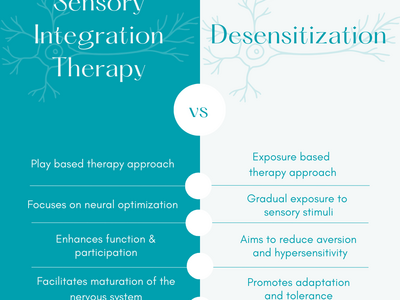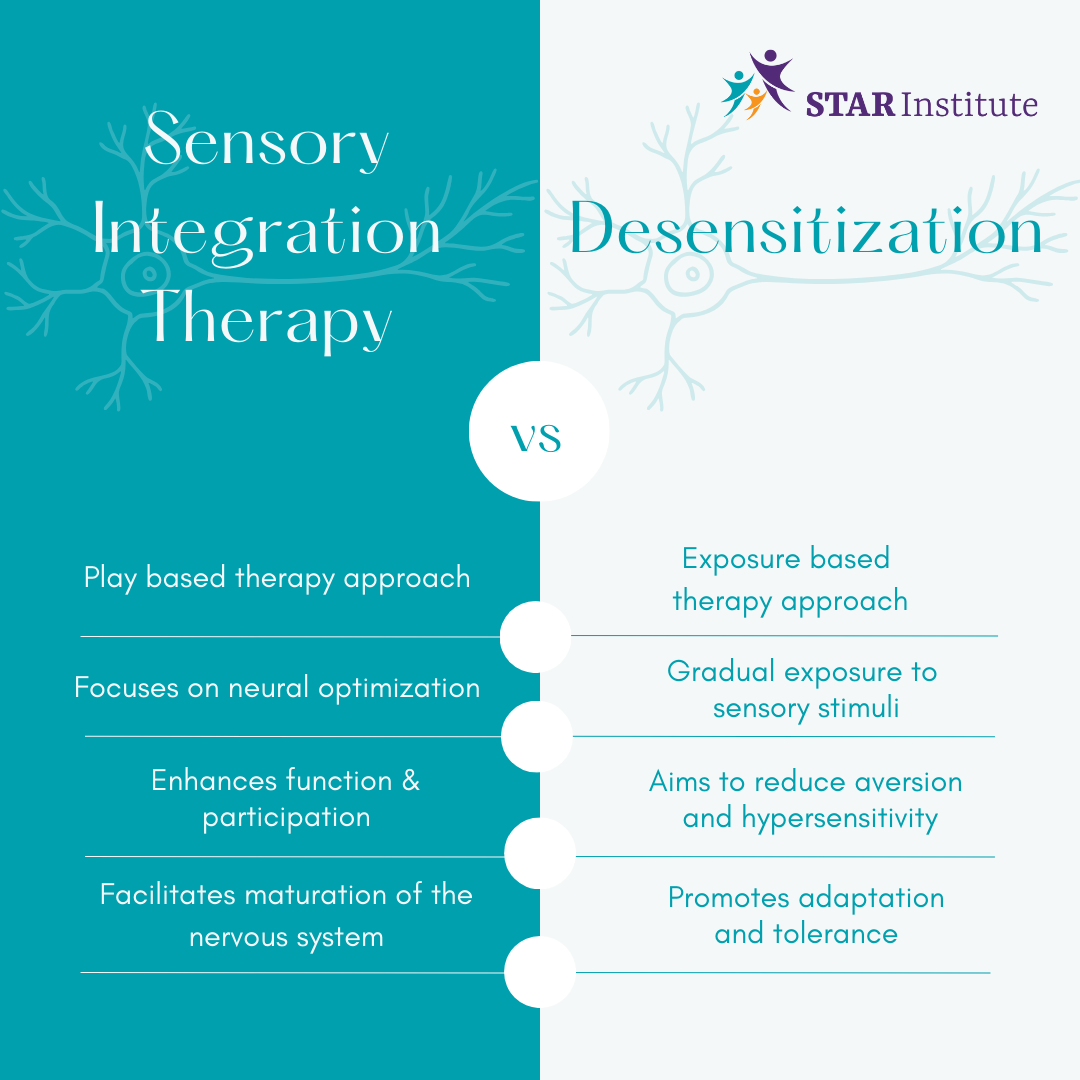Sensory Integration Therapy vs. Desensitization

Differentiating the Concepts
With regards to differences in sensory integration and processing, two terms often come up in discussions: Sensory Integration Therapy (SIT) and desensitization. While they may seem similar, it is crucial to understand that these approaches have distinct foundations and outcomes.
Sensory Integration Therapy
Sensory Integration Therapy, developed by occupational therapist Dr. A. Jean Ayres, is a holistic approach that aims to enhance sensory processing and integration in individuals. SIT recognizes that the brain receives and interprets sensory information from the environment, and when this process is disrupted, it can impact various aspects of an individual's functioning. The focus is on enabling growth of the individual by providing the just right experiences that help them to make sense of what they are sensing and respond the way they want to.
The process of sensory integration relies on the nervous system's ability to receive, interpret, and synthesize sensory information. The brain's sensory processing areas, such as the somatosensory cortex and the parietal lobe, play vital roles in this process. Time and again research has demonstrated that individuals with differences in sensory integration have differences in their brain and nervous system.
Sensory Integration therapy (as conceptualized by Ayres) aims to facilitate the development of these neural connections through carefully supported play that provides sensory input in semi-structured and meaningful ways. By engaging in activities that both organize and challenge the sensory systems, individuals gradually develop capacity to (i) process and integrate sensory information more effectively and (ii) develop the ability to move and organize their body in increasingly efficient and sophisticated ways.
Desensitization
Desensitization, on the other hand, is a specific technique used to reduce an individual's sensitivity or aversion to certain sensory stimuli. It is commonly employed in cases where individuals experience extreme distress or avoidance behaviors in response to specific sensory inputs.
Neurological Underpinnings of Desensitization:
Desensitization primarily operates on the principles of habituation, which refers to the nervous system's ability to diminish responses to stimuli that is familiar and non-threatening. When an individual is repeatedly exposed to a particular sensory stimulus in a controlled and gradual manner, neuroplasticity allows the brain to modify its response and reduce sensitivity.
Desensitization techniques often involve exposure therapy, where the individual is gradually exposed to the feared or aversive stimulus, starting with low-intensity levels and gradually increasing. Over time, the brain adapts, and the individual becomes less responsive or reactive to the previously distressing stimulus.
Differentiating Ayres Sensory Integration Therapy from Desensitization
While both Sensory Integration therapy and desensitization involve sensory experiences, their underlying philosophies and goals set them apart.
Approach: Sensory Integration Therapy focuses on supporting the natural development of sensory processing and integration across various sensory domains, aiming for overall functional improvements. Desensitization, in contrast, aims to reduce aversion or distress associated with specific stimuli.
Scope: Sensory Integration Therapy addresses the broader aspects of sensory processing and integration, encompassing sensory modulation, postural control, and praxis. Desensitization, on the other hand, targets specific sensory triggers and aims to reduce the associated negative responses.
Neurological Impact: Sensory Integration Therapy promotes the development of neural connections and integration of sensory information, leading to improved self-regulation, posture, motor outputs and ultimately function and participation. Desensitization primarily works on reducing the brain's sensitivity to specific stimuli through processes associated with habituation.

Neuroplasticity
Both Sensory Integration Therapy and desensitization utilize principles of neuroplasticity, but they differ in their specific applications and outcomes. Sensory Integration therapy harnesses neuroplasticity by providing carefully designed sensory experiences and activities that aim to promote the development of neural connections and integration of sensory information. Through repeated and meaningful sensory input, the brain adapts and forms new pathways, leading to improved sensory processing and functional abilities. Sensory Integration could be described as therapeutic activity that facilitates maturitation of the nervous system to support client's in becoming their favorite selves. In contrast, desensitization relies on neuroplasticity to reduce sensitivity to specific stimuli. By gradually exposing individuals to the feared or aversive stimulus, the brain undergoes adaptive changes, resulting in a decreased response over time. While both approaches leverage neuroplasticity, Sensory Integration therapy focuses on overall sensory processing and integration, while desensitization targets specific triggers and aims to reduce sensitivity to those specific stimuli.
TLDR: Sensory Integration Therapy and desensitization have distinct approaches, goals, and neurological underpinnings. SIT focuses on enhancing overall sensory processing and integration, while desensitization aims to reduce sensitivity to specific stimuli.
